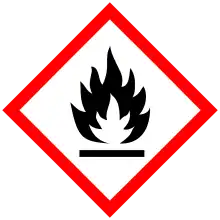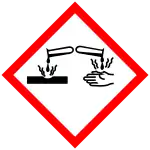 | |
| Names | |
|---|---|
| Preferred IUPAC name
4-Ethenylpyridine | |
| Other names
4-VP | |
| Identifiers | |
3D model (JSmol) |
|
| 104506 | |
| ChemSpider | |
| ECHA InfoCard | 100.002.593 |
| EC Number |
|
PubChem CID |
|
| UNII | |
CompTox Dashboard (EPA) |
|
| |
| |
| Properties | |
| C7H7N | |
| Molar mass | 105.140 g·mol−1 |
| Appearance | colorless liquid |
| Density | 0.988 g/cm3 |
| Boiling point | 62–65 °C (144–149 °F; 335–338 K) 15 mmHg |
| Hazards | |
| GHS labelling: | |
      | |
| Danger | |
| H226, H301, H314, H315, H317, H319, H330, H334, H411 | |
| P210, P233, P240, P241, P242, P243, P260, P261, P264, P270, P271, P272, P273, P280, P284, P285, P301+P310, P301+P330+P331, P302+P352, P303+P361+P353, P304+P340, P304+P341, P305+P351+P338, P310, P320, P321, P330, P332+P313, P333+P313, P337+P313, P342+P311, P362, P363, P370+P378, P391, P403+P233, P403+P235, P405, P501 | |
Except where otherwise noted, data are given for materials in their standard state (at 25 °C [77 °F], 100 kPa).
Infobox references | |
4-Vinylpyridine (4-VP) is an organic compound with the formula CH2CHC5H4N. It is a derivative of pyridine with a vinyl group in the 4-position. It is a colorless liquid, although impure samples are often brown. It is a monomeric precursor to specialty polymers. 4-Vinylpyridine is prepared by the condensation of 4-methylpyridine and formaldehyde.[1]
4-VP is sometimes used in biochemistry to alkylate protein cysteine residues. When compared to other alkylation agents, such as iodoacetamide, acrylamide, and N-ethylmaleimide, 4-VP is less reactive, meaning the completion rate of cysteine alkylation is lower, but it also yields fewer side reactions.[2] For some uses, such as during mass spectrometry measurements, 4-VP might be better because it is basic and can thus be protonated, adding net charge.[3]
See also
References
- ↑ Shimizu, Shinkichi; Watanabe, Nanao; Kataoka, Toshiaki; Shoji, Takayuki; Abe, Nobuyuki; Morishita, Sinji; Ichimura, Hisao (2007). "Pyridine and Pyridine Derivatives". Ullmann's Encyclopedia of Industrial Chemistry. Weinheim: Wiley-VCH. doi:10.1002/14356007.a22_399. ISBN 978-3527306732.
- ↑ Suttapitugsakul, Suttipong; Xiao, Haopeng; Smeekens, Johanna; Wu, Ronghu (2017). "Evaluation and optimization of reduction and alkylation methods to maximize peptide identification with MS-based proteomics". Molecular BioSystems. 13 (12): 2574–2582. doi:10.1039/C7MB00393E. ISSN 1742-206X. PMC 5698164. PMID 29019370.
- ↑ Sechi, Salvatore; Chait, Brian T. (1998-12-01). "Modification of Cysteine Residues by Alkylation. A Tool in Peptide Mapping and Protein Identification". Analytical Chemistry. 70 (24): 5150–5158. doi:10.1021/ac9806005. ISSN 0003-2700. PMID 9868912.